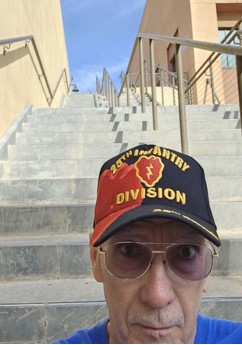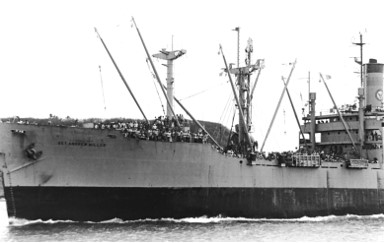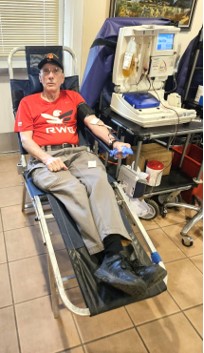
MARK H. FINLEY - FORMER ARMY E-4
Army Journalist Interviewed Saigon Evacuees on Guam

Question: What do the US Army and an autodidact, neoteric, polymath, and sesquipedalian have in common?
Answer: Former Army E-4 Mark H. Finley!
This question may seem strange when discussing military enlistments. After all, when serving in the military, rules must be followed; order and discipline must prevail. But there is another aspect to be considered – the tools and skills each trainee brings with them.
Mark H. Finley’s own tongue-in-cheek recap of his military and civilian careers focuses on just that.
Mark spent two years in the Army. During that time and throughout his life, he applied these unique skills to every military assignment, job, volunteer work, and learning experience, as well as in his personal life.
How does he do that? “I always want to be the best at anything I do,” Mark said. “I analyze each job, figure out how to prepare so I can be the best.” He also leaves nothing to chance. He only takes action after he analyzes each situation evaluating the outcomes – no matter what walk of life he is in.
So how did the Army and civilian employers benefit from this man with an unusual set of skills? Here are some examples:
Mark, the audodidact:
- He slid through high school, mostly teaching himself after digesting his textbooks in a few days. This gave him time to develop his wisecracker persona.
- The Army wanted him to be a cryptographer at The White House, based on his ARVAB score. Instead, he chose to be a military journalist in Hawaii, meeting a personal goal at the government’s expense. “My wife (at the time) and I had both enlisted and did a unit-of-choice for Hawaii. So I turned down the White House because of my marriage and I also despised Nixon” he explained.
- He taught himself enough about Army regulations to keep himself out of trouble whenever his wisecracker persona would surface.
- When he started repossessing cars (repo) as a civilian, he taught himself locksmithing, car towing, and how to modify a truck to streamline the process.
Mark, the neoteric:
- This early adopter of new ideas was the first deputy in the Bernalillo County Sheriff’s Office (BCSO) to carry a side-handled baton after he saw one while on vacation in California. The BCSO approved it after he did a demo; later the Albuquerque Police Department started using it.
- He was the first EMT-certified deputy in BCSO in 1979.
- He began carrying a laptop and portable printer in his patrol car to do reports in 1989.
- And he is getting one of the first solar electric vehicles, an Aptera.
Mark, the polymath: Robert A. Heinlein wrote, “Specialization is for insects. A human being should be able to change a diaper, plan an invasion, butcher a hog, conn a ship, design a building, write a sonnet, balance accounts, build a wall, set a bone, comfort the dying, take orders, give orders, cooperate, act alone, solve equations, analyze a new problem, pitch manure, program a computer, cook a tasty meal, fight efficiently, die gallantly,” fueling his insatiable desire to learn many things, Mark simply studied a topic until he exhausted its essence and applied the knowledge. “I have done all of those things except planning an invasion, so far,” he admitted.
Mark, the sesquipedalian: Mark uses big words as a sort of therapy. “I isolate myself from the emotional impact of events to remain functional. Instead of seeing a suicide scene where the victim blew their brains out, I would say it in my head as ‘Victim was seated on the left side of the couch facing north with a revolver in his right hand. There was an entry wound with powder burns below the rear of the right mandible with an approximately 4″ exit wound at the left parietal with corresponding blood splatter and a possible bullet hole on the west wall.’”
GROWING UP: The son of a police chief in Minnesota, Mark was bored in school. That continued after the family moved to Los Angeles at age 11. He learned a lot on his own, and on his own terms. “My grades were A’s and B’s while taking honors and accelerated classes. I spent a lot of time in the hall for baiting my teachers with my sense of humor. I could set up my teachers because I could predict what they would say,” he explained.
Mark took two semesters at nearby Harbor College while working in a steel mill. His resolve to enlist, putting his life on the line for a worthwhile cause, arose out of the ashes of an explosion at the mill that took the lives of 11 coworkers – an experience that still haunts him. He saved one coworker.
THE ARMY: He enlisted in the Army in 1974 and did basic training at Fort Ord. While in charge of new recruits, he never had to do guard duty or pull KP, but he did have to wake up every two hours to post the next guard shift. He earned one stripe at the end of basic and another one after AIT. Disappointed that he did not get promoted to E-4 after he passed the College Level Examination Program to earn an AA degree as his Recruiter promised, Mark took matters into his own hands. He promoted himself to Command Private Major and created an insignia to match. He was later promoted to E-4. “There was some discussion about punishing me, but I said they should punish the recruiter who lied to me,” he proclaimed.
Shenanigans and hijinks followed him. His sense of humor didn’t suit a lot of people, especially in the Army. “I did get offered a few Article 15’s, though I was never demoted,” he said. “I was never Article 15ed. I always demanded a court martial, and the matter was always dismissed. The JAG colonel did not approve of abusing enlisted personnel with bullshit and pretext,” he said.
Contrary to what you may be thinking, Mark took his time in the Army seriously. He was on the Commanding General’s personal staff, as senior writer for the Tropic Lightning News for the 25th Division. He was an E-4 but was supervising a staff of writers up to E-7’s. “It’s always better to talk things down. It’s easier to keep the peace than it is to pick up the pieces,” he would say, reiterating a concept he learned in AIT at the Defense Information School. He was a good writer and a good editor, and he always researched his articles.
Mark went to Guam to write about the Vietnamese refugee camps during the Saigon evacuation. He worked alongside troops, wrote about their experiences, and took photos. The Army published his photo of the 100,000th Vietnamese refugee on Guam, a cute little Vietnamese girl, and it was shown around the world.

However, at the time the credit was always “U.S. Army photo”, no mention of the photographer. He wrote an article about one military truck pulling in front of another truck that had lost its brakes on a steep downhill cliffside, to slow it down. After the driver’s commander read the article, he gave the driver a Army Commendation Medal. Mark liked that.
He used his autodidactic skills to research military discharges for another article. Then he tested the rules of discharge when he caught a military flight to March AFB in Riverside, CA – effectively meeting the definition of going AWOL. (He was motivated to get back to California for his mother’s heart surgery but his company commander denied his request.) He turned himself in at Ft. Ord. Instead of getting an AWOL charge, the Command Sergeant Major in charge of the PIO wanted Mark to work for him. “We were in the same class at the Defense Information School. He knew my work,” he said. Mark covered front page stories. One was a scheme to charge rent for base housing at Ft. Ord, and another was an inside look at Recon School in Hawaii (he got that assignment because of his physical strength (from martial arts) and his strong writing skills. He exited from the Army at Ft. Ord in 1975, as his mother was having one of the early heart bypass surgeries.
The Army did not specify Guam in his TDY orders, so he later had to prove he was there so he could get on the Agent Orange health registry. This was important when he was later diagnosed with ischemic heart disease (a presumptive for Agent Orange exposure). His VA health insurance covered major heart surgery – two bypasses and an aortic valve replacement, during which his heart stopped twice. His lifetime of physical fitness helped him in recovery.
CIVILIAN LIFE: Back in civilian life, Mark used the same skills he always relied on: “Learn as much as you can about your options, choose the best option and then do what you have to do to be the best one doing it,” he recalled.
“Most of my civilian jobs focused on keeping people safe and alive. I was a Deputy Sheriff with EMT training, I’ve saved lives with Narcan, I was a C.E.R.T. Instructor, and I’ve taught suicide prevention classes at Forward Flag (a veteran wellness center in Albuquerque where he now works),” he said. (See related article about Forward Flag.)
He wanted to be the third generation of cops in his family, in California. Since he could not pass the vision test there, he moved to New Mexico. He eventually was hired as a deputy for the Bernalillo County Sheriff’s Office (BCSO) from among 1,000 applicants. “I was happiest when I worked at BCSO,” he reminisced. Seeking higher pay, he had eye surgery similar to Lasik, passed the eye test in California and worked for the San Bernadino County (CA) Sheriff’s Office.
After 20 years in law enforcement, Mark and his wife went into the car repo business for the next 18 years. He wanted them to work together and needed the higher income for medical bills. He taught himself locksmithing, how to tow vehicles, and how to defuse frustrated car owners with wit and “talking things down”.
GIVING BACK: In 2018, he quit the repo business and moved back to New Mexico. He drove for Uber and Lyft while job hunting. He started the Transit Enforcement Officer’s Narcan training program (use of naloxone for opioid overdose). When a new manager stopped the program, Mark taught it on his free time. “I had three Narcan saves in that job, and stopped an attempted suicide” he reflected. ”One guy was standing on the top guard rail of the ART station at Central and University with a rope around his neck and then he stepped off when backup officers came on scene. I cut him down within 3 seconds.”
Two years later, a lingering sense of fatigue was the harbinger of his heart problems. The heart operations came next. His lifetime of physical fitness aided in his recovery.
Mark found Forward Flag when he was at the VA Rec Center. “In 2021, I helped move them to the current location on Aztec Road. I drove a forklift and did whatever I could,” he said. “I was going there to get out of the house. Then I started volunteering, helping with the program’s flagship suicide prevention training.” That eventually led to his current job there as the receptionist and the do-whatever-needs-doing jack-of-all-trades. As the office “face” of Forward Flag, he does everything from welcoming vets and visitors, to creating spreadsheets, to fixing furniture, to marketing the center’s programs, to belting out songs of the 70’s with the center’s guitar teacher (much to the delight of veterans at the center).

Mark is involved with other organizations that help veterans. He helped with the Honor Flight car show fundraiser at the Veterans Memorial in Albuquerque, was a volunteer with Qualified Listeners, a program to help veterans do yard work etc., and donates blood in the Blue Star Mother’s “Battle of the Branches” Challenge. When not volunteering, Mark works out daily in his eclectic home gym. He has four adult children. They are self-sufficient, hardworking, and seem to have inherited some of Mark’s insatiable appetite for learning. “One of them taught himself four languages,” Mark said proudly. Mark continues to make a diference through them.